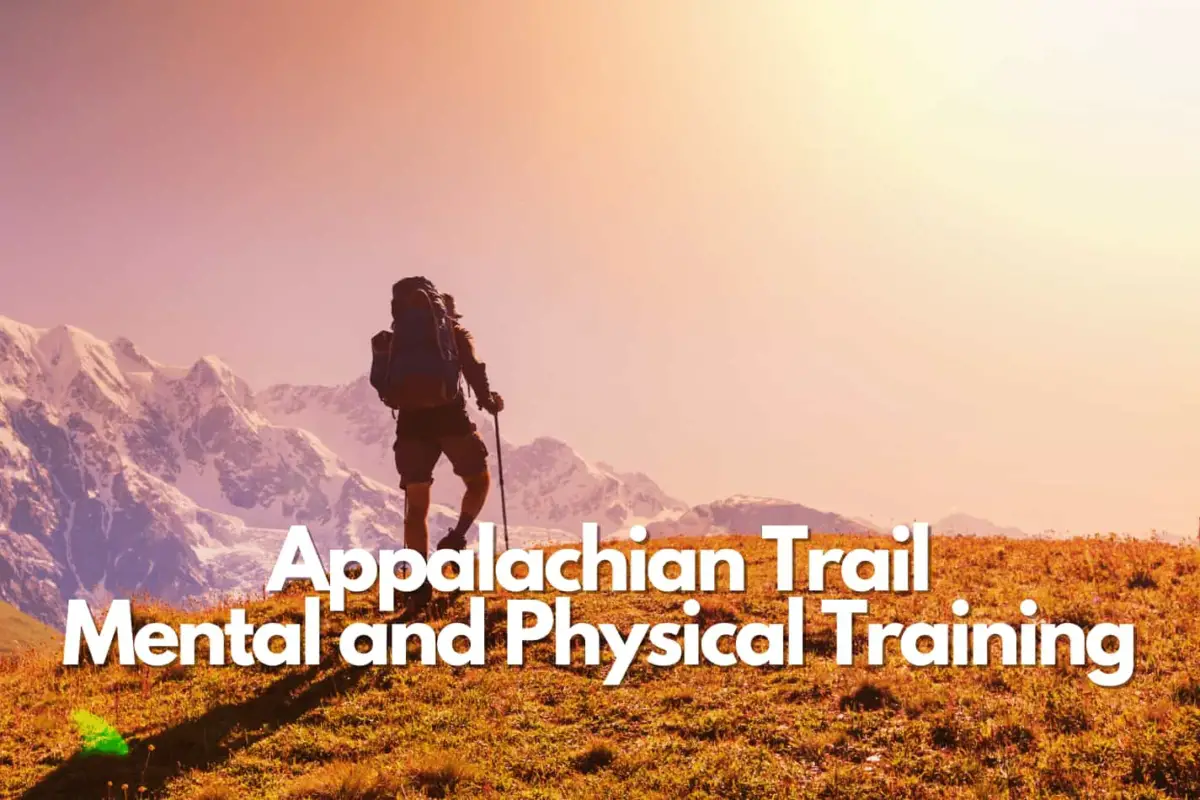Preparing for a thru-hike on the grueling Appalachian Trail is much more than lacing up your boots and hitting the trail. You must train your body and mind to complete the 2,000+ mile journey from Georgia to Maine.
This training should begin at least a year in advance and include aerobic, anaerobic, and resistance exercises to build full-body fitness. Just as important as your physical preparation is strengthening your mental resolve. Tactics like getting comfortable with solo hiking, reading others’ experiences, and journaling can help you stay motivated when the going gets tough.
Proper rest and recovery are also paramount to avoid injury and fatigue. If you balance your training, take time off while adding outdoor games like disc golf, and ready both your body and mind, you’ll be prepared to take on the iconic Appalachian Trail, so let’s dive in.
How You Should Train For An Appalachian Trail Thru-Hike
While the outward appearance of preparing for a 2000-mile-long trek may appear that you have to focus on your training exercises and physical preparation, the thing that takes out many thru-hikers long before their body is their mind.
Mental Resolve
While many feel an accident or injury will be what takes them off the trail, what ends up causing them to quit is the mental exhaustion and isolation that creep in after weeks and months of being on the trail.
You must prepare your mind for long periods without the comforts and massive social interaction you’re used to in your everyday life. It can be a difficult adjustment for many.
Part of training your mind for a thru-hike is to get used to being alone and enjoying your own company. This can be done by taking solo hikes regularly in the months leading up to your thru-hike.
Start small with day hikes, and work up to weekend backpacking trips. The goal is to get comfortable in the wilderness alone for extended periods. This will help you mentally prepare for the solo nature of a thru-hike.
Another way to train your mind for a thru-hike is to read books about other peoples’ experiences on the many thru-hiking trails, like the Appalachian Trail, the Continental Divide Trail, and the Pacific Crest Trail.
Reading will help to provide you an idea of what to expect, both mentally and physically, during your own thru-hike.
Finally, one of the best ways to mentally prepare for a thru-hike is to talk to others who have done it. There are many online forums and Facebook groups dedicated to Appalachian Trail thru-hikers.
These are great resources for learning about the mental challenges you may face during your hike.

Physical Ability
Of course, a long-distance hike will require some physical ability, but while it helps, you will continue to build this up as you hike.
More important is training your body to hike long distances with a loaded backpack. This will help get your body used to the physical challenges of hiking all day, every day, for months on end.
Start by going on regular hikes with a fully loaded backpack. Begin with shorter hikes and gradually increase the distance and duration of your hikes as you get in better shape. Do this regularly in the months leading up to your thru-hike.
In addition to training your body to hike with a backpack, it’s also necessary to do some strength training at a gym or, if you can, a home gym set.
This will help you build the muscle and joint strength necessary to carry a heavy backpack long distances.
Finally, doing cardio training is vital to increase your overall fitness level. This will help you hike longer distances with less effort. Cardio training includes running, swimming, biking, or endurance cardio machines.
Choose an activity you enjoy and can stick with for the long haul.
How Long Before Leaving Should You Begin Training For Your AT Thru-Hike?
For most people, this training will begin at least a year before starting their thru-hike. This timeline gives you ample time to focus on the mental and physical training necessary for a successful thru-hike.
Of course, if you don’t have a year to train, that’s okay. Many people have started training just a few months before their hike and have been successful, but the sooner you can start assembling and enacting your plans, the better your hike will be.

Physical Training & Preparation
Your fitness plan must be broad and cover a wide range of strength, aerobic, and anaerobic training.
Ideally, you should be doing aerobic and anaerobic training in the months leading up to your thru-hike. This will help you build the endurance necessary for long days of hiking and the strength necessary to carry a heavy backpack.
Example Training:
- Aerobic training includes biking, running, and swimming.
- Anaerobic training includes activities like weightlifting and sprinting.
- Strength training is essential to build the muscle and joint strength necessary to carry a heavy backpack long distances.
Also, in all this training, remember the most important training is to go load up your backpack and do real hikes for multiple days. Someplace like the Foothills Trail is a perfect match to expectations on the AT, allowing good shakedown hikes on gear to occur.
Building a Physical Training Program
It’s crucial to focus on training the specific muscles during a thru-hike. These include your leg, core, and arm muscles, as you will use these three more frequently than you may initially assume.
You can train these muscles without weights or machines by doing squats, lunges, sit-ups, pull-ups, and push-ups. In addition to strength training, you should also focus on cardio training to increase your overall fitness level.
This can include running, biking, swimming, or using an endurance cardio machine. Choose an activity you enjoy and can stick with and enjoy for the long haul.
Aerobic Training
Aerobic training is any activity that gets your heart rate up and keeps it there for an extended period. While on the trail, you will be looking to hike 8-12 hours a day, which means you must sustain that pace.
The best way to train for this is by doing activities like hiking with a pack, running, biking, or swimming. These activities will help increase your overall fitness level and prepare your body for the physical challenges of hiking all day.
Anaerobic Training
Anaerobic training is any activity that increases your heart rate for a short burst, followed by a recovery period. This is important because, on the trail, you must be able to hike uphill for sustained periods of effort and time.
The best way to train for this is through weightlifting, sprinting, or interval training. These activities will help build the muscle and joint strength necessary to carry a heavy backpack long distances.
Interval training is anaerobic training that alternates between high-intensity and low-intensity activity periods. This is a great way to train because it closely simulates the physical challenges of hiking uphill for long periods.

Resistance Training
Using weights to help build stronger muscles is an integral part of preparing for a thru-hike. While less important than aerobic and anaerobic training, it is vital for body balance.
This training will help build the muscle and joint strength necessary to carry a heavy backpack long distances, especially if you are a SOBO hiker starting in Baxter State Park.
Climbing up and then Katahdin down will be an insane level of arm and leg work.
The best way to do this is by lifting weights 2-3 times weekly. Start with lighter weights and gradually increase the weight you lift as your body gets stronger.
You can use your gym membership to access free weights or machines, or you can add them to your home so that you can always have no excuse to do the work.
Focus on Training Your Body By Utilizing Actual Hiking
Although much of the information from internet forums is superficial, specificity is essential when preparing for a hike. Several long hikes simulate what it will be like on the trail and should, therefore, be done to prepare.
The main issue is increasing difficulty too fast. Instead, take your time in increasing difficulty as your body must adjust. If you work a desk job, training for a thru-hike will be a massive change for your body, and it needs time to adapt.
I began training as a novice hiker by wearing at least the pack weight I planned to carry + 5% to help cover food or water changes on the trail. Then, gradually work on increasing the distance and elevation of each shakedown by 10 to 20 percent weekly.
My first LSHT training hike was six months before my Ouachita Trail trek start date, during which I covered loops and got a feel for how the pack would work over longer miles, as it does feel different in mile 1 than in mile 10!
Since the Lone Star Hiking Trail is mostly flat, I am planning another 3-day trip out on the Eagle Rock Loop Trail specifically to get some more peaks and distance to grab some real climbs and descents as these work your legs in unique ways machines fail at training.
If you don’t have regular access to real mountains or the time to climb them regularly, there’s no need to stress yourself out and worry as you can prepare by walking as much as possible.
I would encourage people living in areas without many inclines to seek out flights of stairs in stadiums, parking garages, or buildings, as this similarly pushes your muscles.

Take Time Off and Be Serious About Recovery
In addition to training your body, focusing on recovery is also critical. This includes things like foam rolling, stretching, and taking days off from training.
One of the biggest mistakes people make when training for a thru-hike is not taking enough time off. Respecting the process and understanding that your body needs time to recover from training is important.
Foam rolling is a great way to improve blood circulation and help your muscles recover. I use a foam roller every night or the good old cork ball I take hiking after training to help my muscles recover.
Stretching is also important for recovery. I like to do a dynamic stretching routine before training and a static stretching routine after training.
I also recommend taking at least one day off per week from training. This will give your body the time to recover and prevent overtraining.
Mental training & prep for an AT Thru-Hike
The straw that breaks the camel’s back is mentally fatiguing, especially on the Appalachian Trail with constant rain, cold, and other hikers who are miserable.
Start by training your mind to be more optimistic. This will help you in all walks of life, but especially on the trail when things seem to be going wrong constantly.
Most first-time thru-hikers are mentally unprepared for the long haul and think they can “tough it out.” This is a recipe for disaster and will only lead to misery.
Missing Loved Ones
A considerable issue is one people may not consider before they hit the trail with their first footfall. Leaving my wife and daughter is the most challenging part of any trip. Not being prepared for homesickness can wear a person down mentally.
I like to stay in touch with my family as much as possible while I’m on the trail. I bring my Zoleo to be connected with at least daily start and end day messages, which also means I can get emergency notices from them.
This includes sending them postcards from towns, calling when I can, and writing long letters when I can.
I also find it helpful to keep a journal, use notes on my phone, and write down my thoughts and feelings about each day, both the good and the bad.
Julia Sheehan used this style of process to convert each hike into a book which I find absolutely amazing and hadn’t considered prior!
This is a very simple way to process what I’m going through and helps me see the positive when re-reading my entries.
It’s also important to remember that they are missing you just as much as you are missing them, so don’t forget to show your appreciation when you get back!
Belief in Sheer Willpower
Many hikers believe their stubbornness is enough to get them to Katahdin. While this may be the case for some, most people need more than just willpower to make it to Maine.
It’s important to have a solid plan and a sound support system in place.
I also find having a “Why” for hiking the Appalachian Trail helpful. This could be nearly anything from wanting to see the beautiful scenery to needing time to clear your head or simply wanting to challenge yourself.
Whatever your reason, make sure it will keep you motivated when things get tough, like your fourth day in constant rainfall when all your clothes are cold and wet.
Final Thoughts
Start training for your Appalachian Trail thru-hike today, and you’ll be on your way to completing one of the world’s most challenging and rewarding hikes.
Just remember to focus on your physical and mental preparation; you’ll be ready to take on anything the trail throws your way.
Make sure to balance out your training, though, to use mental and physical training, and don’t forget to take some time to rest and relax!


Leave a Comment